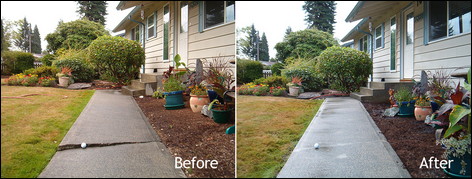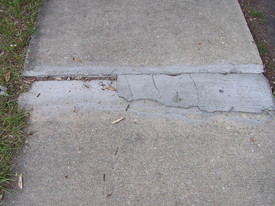Step on a crack –- break your mother’s back. That rhyme may have been hilarious in grade school, but cracks in your driveway, patio or sidewalk aren’t so funny when they decrease your property value or create a safety issue. We’ll take you through a few concrete repair projects to help guide your approach.
 This concrete repair effort was inadequate. Proper concrete repair will result in a lasting solution. Photo courtesy of Karen Queen. |
First: a quick primer on why and how concrete cracks, settles and blisters. “As concrete cures, moisture leaves the concerete and it shrinks,” says Paul Gaudette, of Wiss, Janney, Elsner and Associates in Chicago, chair of the American Concrete Institute’s Concrete Repair Committee, and an instructor in ACI’s concrete repair seminars and workshops. “That shrinkage can cause cracking in the concrete.”
Concrete also can crack when the ground underneath settles over time, creating an uneven surface. “If the concrete is installed on grass or black dirt instead of packed clay, it can settle because it doesn’t have the right kind of base underneath,” says Robert Joyce, president of Quality Restorations in Wood Dale, Ill., an instructor in ACI’s concrete repair seminars, and a member of ACI’s Concrete Repair Committee.
Concrete blisters because of big changes in temperature, often in cold climates, or because the surface was improperly finished during installation, Joyce and Gaudette say.
Plan Your Attack
Badly repaired concrete can look worse than the original problem and worse yet, can crack again in the same spot if you don’t address the issue that caused the problem. But done correctly and with the proper tools, a day’s work can eliminate trip hazards and the worry of someone falling on your property.
Whether you’re doing it yourself or hiring a pro, consider a trial repair of a small section to see if you like the results, Gaudette says.
Caveat: If a crack is structural, i.e. in the home’s foundation, call a pro.
Project One: Driveway crack caused by one-time heavy load.
The best candidate for a DIY concrete repair is a cracked driveway corner near the street where the crack was likely caused by a heavy truck driving over the corner.
“From a one-time event such as an overload, you can basically glue the driveway back together,” Gaudette says.
Tools Needed:
- Leaf blower or compressed air gun
- Grinder with a masonry blade,
- Rotary drill with a paddle wheel to mix the epoxy,
- Rubber gloves
- Safety glasses.
- Sealant or caulking, sealant scraper, liquid epoxy – preferably all made by the same manufacturer.
Difficulty level: Medium.
Time: About four hours for the work.
Cost: Under $100 if you have the tools.
How to: First, rout the crack out with the grinder to clean out dirt and contaminants; make the crack wide enough (3/8 inch to ½ inch is the general rule, Gaudette says) for the sealant to work; and to make the repaired crack flexible if the surface settles in the future.. Next, blow the crack out with the leaf blower or compressed air gun to remove any remaining contaminants. “The biggest part of all concrete repair is you have to have the repair area clean so it will accept the new repair material,” Joyce says.
Next, apply sealant or caulking on each end of the crack so the epoxy funnels into the crack. The sealant creates a dam to prevent the epoxy from running out of the crack. Then apply the liquid epoxy into the crack and scrape off the sealant with a sealant scraper. Check back within an hour to make sure the epoxy completely filled the crack and apply more epoxy if needed, Joyce says. Make sure you follow manufacturer’s recommendations for each step of the process.
Stay off the surface for 24 hours to allow the repair to cure.
Read about additional concrete repair methods on the next page.
Project Two: Sidewalk crack caused by ground settling.
Tools Needed:
- Leaf blower or compressed air gun
- Grinder with a masonry blade
- A rotary drill with paddle wheel to mix the epoxy
- Rubber gloves
- Safety glasses
- Concrete primer, sealant, sealant scraper and liquid epoxy -– preferably all made by the same manufacturer
Difficulty level: Moderately hard.
Time: One to four hours, depending on size of the crack.
Cost: Under $100 if you have the tools.
How to: Run the masonry blade through the crack to widen it so it can stand the movement as the soil continues to settle, Joyce says. Then, blow the crack out with a leaf blower as with the driveway crack. Next, apply concrete primer and follow steps, beginning with sealant, for repairing the driveway crack.
Stay off the surface for at least a day while the repair cures.
Project Three: Surface blistering where the top layer of concrete is flaking off in chunks.
 This before and after shows a concrete walkway that was repaired by slabjacking. Photos courtesy of Concrete Slab Jacking, Inc., Maryland USA. Read more about concrete slab jacking at ConcreteNetwork.com |
Difficulty level: Very hard.
“This is a complicated, hard repair to do with mixed results,” Joyce says. For the best results with this kind of concrete repair it is best to call a professional.
Slabjacking is another solution for uneven concrete which you should discuss with a professional. The technology, widely used for years in the Midwest where freezing winters cause more irregular ground settling, is now being employed across the country.
Instead of ripping out the existing concrete, the slabjack company drills small access holes (which are later patched), and then injects a special grout material underneath the existing concrete or exposed aggregate. The injected, pressurized grout material levels the concrete and then dries, providing long-term support. The expansion joint is replaced if needed and any cracks are then sealed with caulk, says Karen Snowden Roberts, vice president for Concrete Jack in Williamsburg, Va. Concrete Jack has leveled surfaces that have settled as much eight inches.
Compared to replacing an entire sidewalk or driveway, slabjacking is environmentally friendly, cost-effective and fast, Roberts says.
Credit: Renovate Your World




























